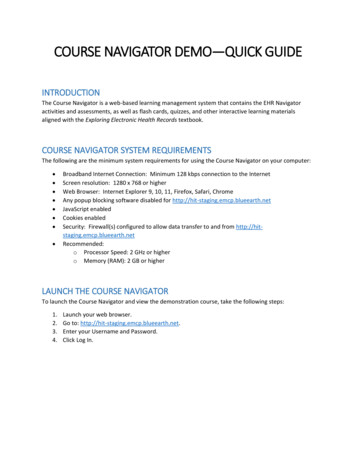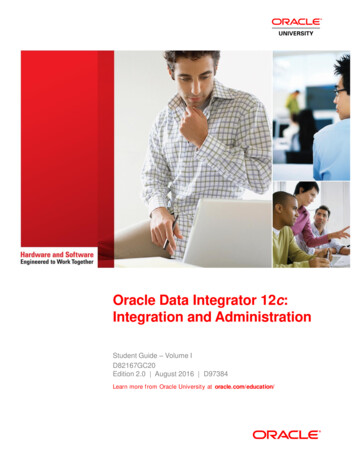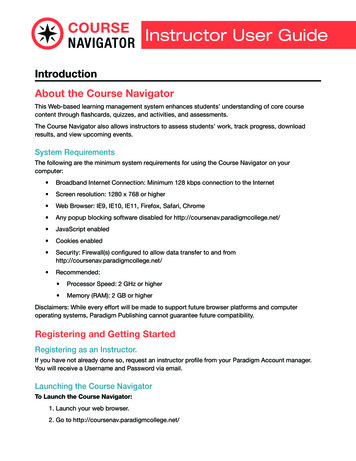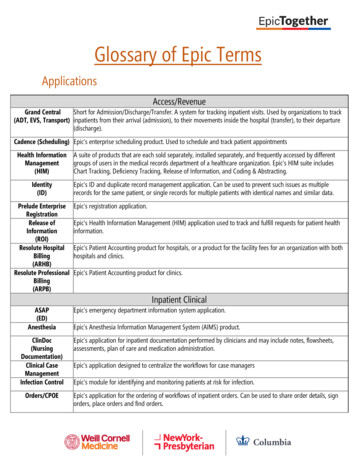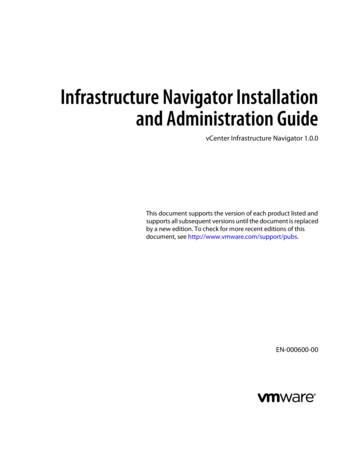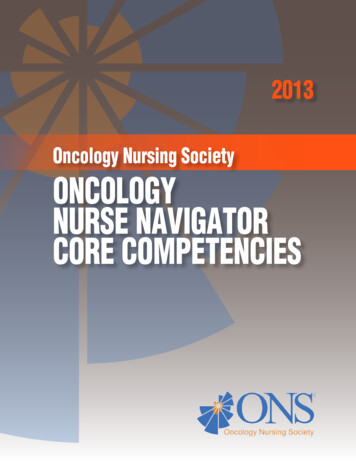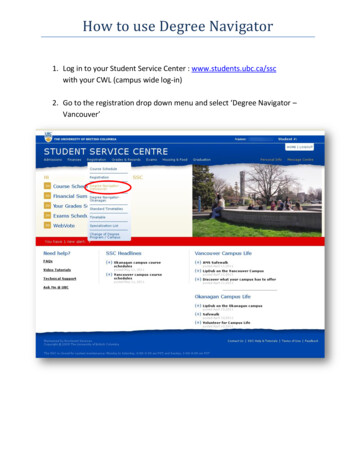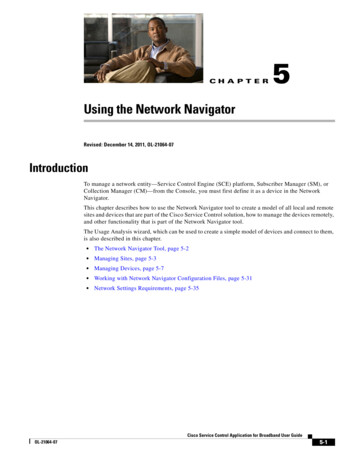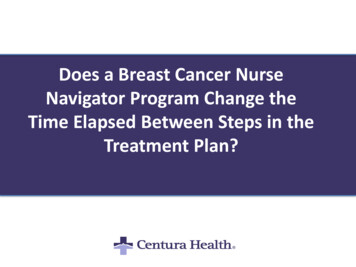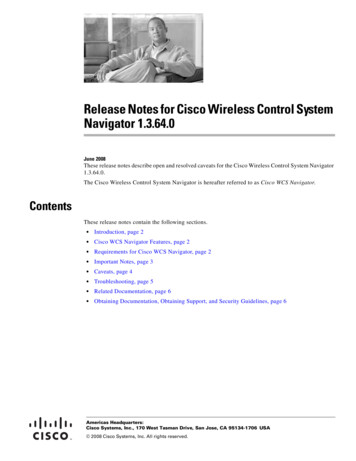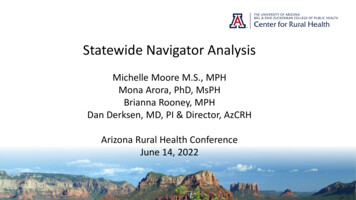
Transcription
Statewide Navigator AnalysisMichelle Moore M.S., MPHMona Arora, PhD, MsPHBrianna Rooney, MPHDan Derksen, MD, PI & Director, AzCRHArizona Rural Health ConferenceJune 14, 2022
Scope and MethodologyQuestion: What are the strengths and weaknesses of thecurrent navigator, eligibility and enrollment systems? Conduct a literature review to identify best practices, models,and landscape of initiatives around the country Conduct key informant interviews to understandbarriers, opportunities and considerations for streamlining AZpublic benefits Coded data using Barriers/Facilitators as the main categories
BackgroundBenefits Data Trust: 2021 60 Billion in public benefits go unclaimed annually in U.S.Center on Budget and Policy Priorities 2021:1 in 8 Arizonans participated in SNAP
Pandemic ImpactAHCCCS Enrollment - COVID403632283833322724206/1912/112/2 SNAP enrollment rose during summer 2020 and 2021 COVIDpeaks but not winter outbreaks12/26/2112/2
Key Trends in Benefits Enrollment Pre-Pandemic Decreasing Poverty Stable Medicaid enrollment Decreasing SNAP enrollmentPandemic Rising Medicaid enrollment Variable SNAP enrollment Initial pandemic job lossesRural Arizonans have higher rates of povertyand more rely on SNAP and Medicaid benefits
How Would a Consolidated PlatformImprove Services?Connects More People toBenefitsReduces workload on CaseManagersSimplifies OutreachPotential to improve health,educational, and employmentoutcomes for applicants
Populations InterviewedKey Informant interviews28 Completed
Regional NavigatorRepresentation13 of 15 AZ CountiesApache, Cochise, Coconino,Gila, Graham, Greenlee, La Paz,Maricopa, Mohave, Navajo,Pima, Santa Cruz, Yuma*Pinal, Yavapai not represented
Stakeholders InterviewedNavigators/Assistors Interviewed AZ Commission for the Deaf & Hard of Hearing AZ Statewide Independent Living CouncilUArizona Center for Rural HealthCherish Families Chicanos Por La CausaCoconino Health DepartmentColorado City FQHC Cornerstone Mission Golden Valley Health CenterSolari Crisis and Human Services 2-1-1 ProgramStatewide Partners Interviewed AZ Department of Health Services AZ Department of Economic Security Arizona Housing Coalition Banner Health, BH AHCCCS TribalLiaison Connections Health Solutions Contexture International Rescue Committee Maternal Infant and Early ChildhoodHome Visiting Program Native Health of Phoenix North Country HealthCare FQHC Pima County Re-entry Program Regional Center for Border Health UArizona Prevention Research Center Wildfire AZ
Theme Frequencies621 Total Coded Themes:Enabling FactorsOutreach - 96Technology - 67 Communication - 54 Human Factors - 46 Accessibility - 41 Requirements - 15Policy - 5BarriersAccessibility- 55 Requirements - 38Communication - 32 Technology - 30 Human Factors - 21 Outreach - 21Policy - 14Special Populations (tribal, elderly, disability)46Attitudes (feeling/emotional statements)23Equity (race, age, discrimination, literacy statements) 18
AccessibilityAccessibility BarriersTransportation“It's a dichotomy that those thatoften need the most to connect tohelp . experience the mostbarriers in trying to find it."Remote locationLiteracy level (tech and reading)Phone/cell phone accessInternet accessLanguage- Interviewee who works for a home visitingprogram across ArizonaStaffing (access to in-person or liveperson)0%10%20%30%40%
OutreachArizona Poverty Rate"12 years after its launch thereare still people who don'tknow that themarketplaces/socialservices are available to them"- Navigator serving in Santa Cruz, Graham,Greenlee & Cochise counties
Human FactorsTheme Frequency Percentage Human FactorsEnabling 22/28 78.6% Human FactorsBarriers 12/28 42.9% "You can't code compassion.You have to hire good people. Andthey burn out and lose patience when theyare overworked. So design a systemthat helps them to do their job better.A data driven approach is important, butyou can't lose sight of the human aspect."- Interviewee who works with probation populations
CommunicationTheme Frequency Percentage CommunicationEnabling 22/28 78.6% CommunicationBarrier 12/28 42.9% "No matter how intuitive youthink you're building a system tobe if you are not asking thepeople who you are going to be applyingthe questions to, you're not going toget the right response"- Interviewee who works with a poverty non-profitbased in Maricopa County
Technology"A dashboard/website whereboth client andNavigator can see all of thebenefits a person might beeligible for would behelpful empowering"- Navigator who works in immigrant and borderhealth
Equity"How do you provideaccess equitably, when accessstill isn't equitable across theboard? Redirecting people tolocal sources is good but somepeople will have far fewer localresources"- Interviewee who works in Maternal and InfantCare
Attitudes
Population NeedsElderly TribalDisabledHomelessEase ofDocumentationRequirementsHuman factorsRural lationsTrust
Recommendations
Recommendations
Q: Is there anything else you'd like to share? 11/28 interviewees were overwhelmingly positive9/28 interviews were slightly positive7 interviews were neutral1 interview was negative
"Excited about exploring the concept; glad to be part of the discussionand be able to access.""I think a one-stop shop is a great idea particularly if it can house bothstate and federal benefits agencies under one website.""Great opportunity to enhance collaboration across a spectrumof social services.”
"Sounds like a really useful platform. Benefits coordination is ahuge challenge impacting access to services" "It is a great idea. It sounds like it has the potential to be easier andmore efficient for people consider building in programs aimed atsupporting self-sufficiency and peer support elements too."“Try to give hope to people who are struggling. There is still a lotof stigma surrounding benefits it would be beneficial to showsuccess stories to change the narrative – this person was on benefitsfor months and now has a stable job, housing, and enough to eat.”
AcknowledgementsUniversity of ArizonaMichelle Moore MS, MPH Mona Arora, PhD, MsPHJennifer PetersBrianna Rooney, MPH Laura Schweers, MSW Joyce Hospodar, MBA/MPA Jill BullockAgnes Attakai, MPA Bryna Koch, DrPH Patrick Wightman, PhD, MPP Dan Derksen, MD Loren Halilli, GRA / Martin Caudillo, GRA Arizona Department of Health ServicesSiman Qaasim, MBA Alicia Kenney, BSW Carla Berg, MHS
Statewide Navigator Analysis. Michelle Moore M.S., MPH. Mona Arora, PhD, MsPH. Brianna Rooney, MPH. Dan Derksen, MD, PI & Director, AzCRH. Arizona Rural Health Conference
